United Kingdom Blood Glucose Monitoring Market Size
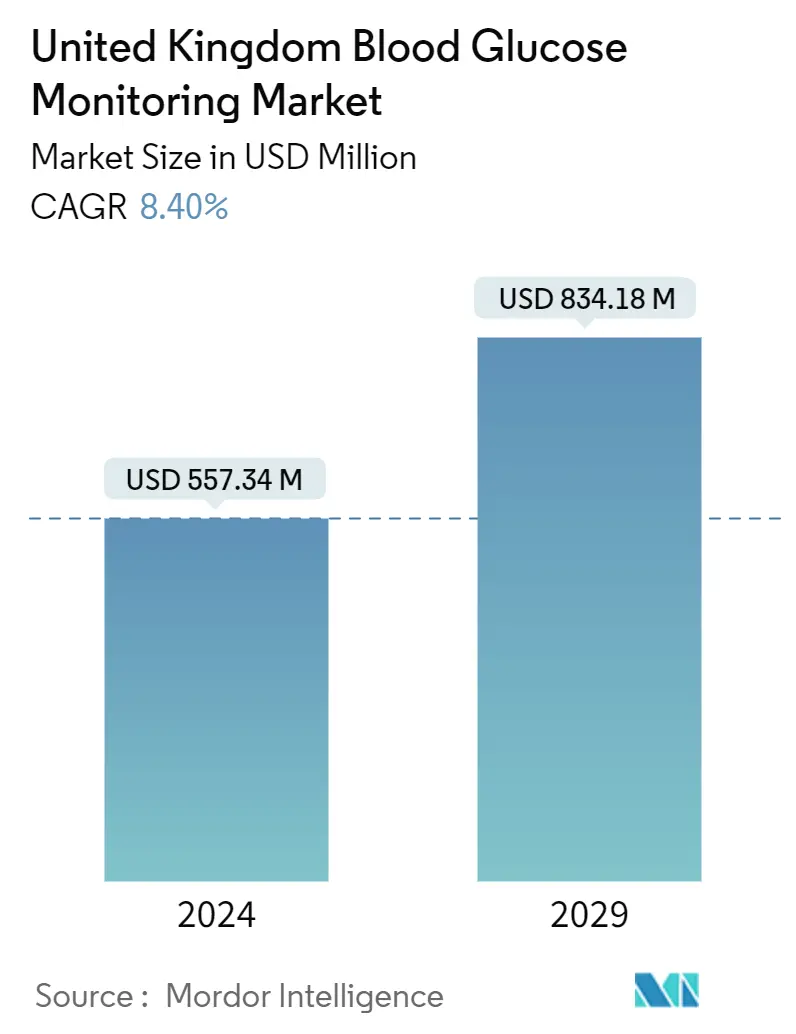
| Study Period | 2021- 2029 |
| Base Year For Estimation | 2023 |
| Market Size (2024) | USD 557.34 Million |
| Market Size (2029) | USD 834.18 Million |
| CAGR (2024 - 2029) | 8.40 % |
| Market Concentration | Medium |
Major Players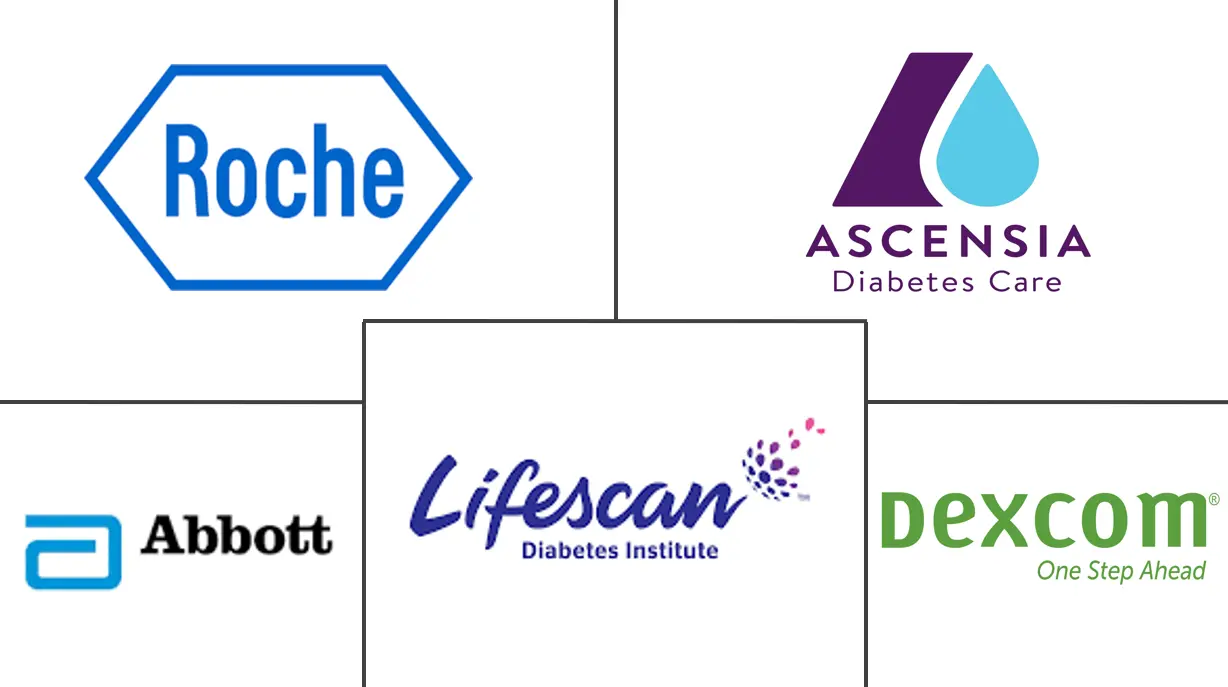
*Disclaimer: Major Players sorted in no particular order |
United Kingdom Blood Glucose Monitoring Market Analysis
The United Kingdom Blood Glucose Monitoring Market size is estimated at USD 557.34 million in 2024, and is expected to reach USD 834.18 million by 2029, growing at a CAGR of 8.40% during the forecast period (2024-2029).
One of the most significant risk factors for a severe course of COVID-19 is diabetes mellitus. This risk is believed to be influenced by several variables that are frequently present in diabetes mellitus, such as advanced age, a proinflammatory and hypercoagulable condition, hyperglycemia, and underlying comorbidities (hypertension, cardiovascular disease, chronic kidney disease, and obesity). Diabetes was quickly recognized as a risk factor for bad results during the COVID-19 pandemic. That's why managing or delaying cases of type 2 diabetes became more important than ever before. Several studies have confirmed that chronic diseases like diabetes are associated with adverse outcomes in COVID-19 patients.
Diabetes is associated with many health complications. Comparing the population with and without diabetes, those with diabetes have a 300% increased risk of being hospitalized and, thus, incur more healthcare expenses compared to non-diabetic people. People with diabetes face a higher chance of experiencing serious complications from COVID-19. In general, people with diabetes are more likely to experience severe symptoms and complications when infected with a virus. Diabetes and high glucose levels are associated with increased complications, respiratory failure, and mortality in hospitalized patients with coronavirus.
According to The British Diabetic Association, 'The pandemic has had, and continues to have, a huge impact on our society. But research and data have shown that people with diabetes have been disproportionately affected by COVID-19, particularly in terms of poorer outcomes when contracting the virus. That's why preventing or delaying cases of type 2 diabetes is more important than ever before.'
The pandemic also highlighted opportunities for continuing and expanding innovations in the delivery of diabetes care, through virtual consultations between healthcare providers and people with diabetes, and the use of diabetes technology. Crisis management has created unprecedented interest in remote care from both patients and providers and removed many long-standing regulatory barriers. Thus, the COVID-19 outbreak increased the blood glucose monitoring market's growth.
United Kingdom Blood Glucose Monitoring Market Trends
Growing Diabetes Population in the United Kingdom
The United Kingdom's diabetes population is expected to grow, registering a CAGR greater than 2% over the forecast period.
In the United Kingdom, the prevalence of diabetes has increased dramatically during the last two decades, a fact driven by the increased prevalence of obesity and lifestyle changes. The country also has the highest obesity population, which is a prominent cause of type-2 diabetes.
According to the British Diabetic Association's Diabetes Prevalence, 2021 data shows an increase in the number of people living with a diabetes diagnosis in the United Kingdom increase of more than 150,000 from the previous year. It is estimated that more than 13.6 million people are at increased risk of type-2 diabetes in the United Kingdom. At this rate, the number of people with diabetes, including the undiagnosed population, is expected to rise to 5.5 million by 2030, as per IDF 2021 statistics.
The rapidly increasing incidence and prevalence of diabetic patients and healthcare expenditure are indications of market growth. Leading manufacturers are focusing on technological innovations and developing advanced products to gain a substantial market share. Technological innovations and advancements offer many conveniences for maintaining blood glucose levels. The vast range of apps in the diabetes field supports the adoption of lifestyle interventions for the prevention and management of diabetes, the evaluation of blood glucose control quality, and the dosing of insulin.
Integration of blood glucose monitoring with insulin calculators, automated insulin titration software, and remote coaching are further developments that provide patients with poorly controlled diabetes with the additional support needed to improve critical outcomes, thereby enhancing market prospects in the years to come.
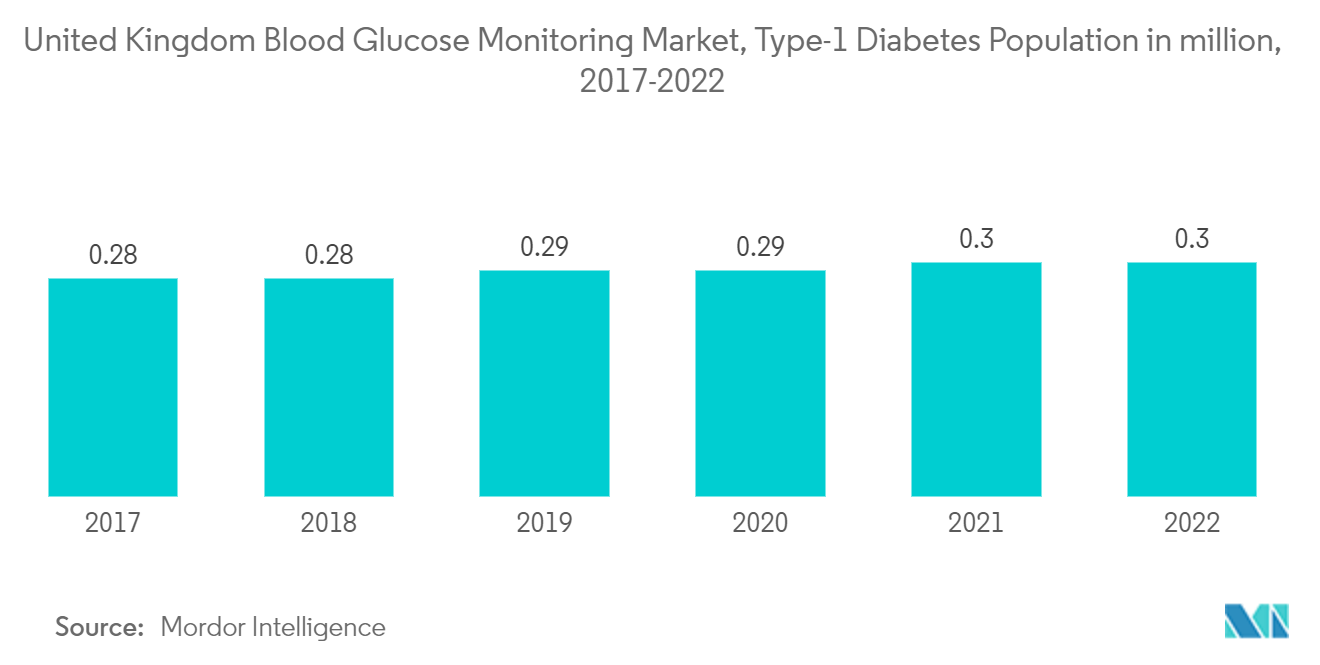
The continuous glucose monitoring segment is expected to witness the highest growth rate over the forecast period
The continuous glucose monitoring segment is expected to register a CAGR of 11.8% over the forecast period.
Continuous glucose monitoring devices are automated glucose monitoring systems that consist of a small device that can be worn on the body and held on by an adhesive patch. The sensor part of the device has a cannula that is inserted into the top layer of skin and uses samples of interstitial fluid to check glucose levels. Sensors are connected to a transmitter that can send data wirelessly to a dedicated mobile receiving device or smartphone. Continuous glucose monitoring sensors use glucose oxidase to detect blood sugar levels. Sensors are the most important part of continuous glucose monitoring devices. Technological advancements to improve the accuracy of the sensors are expected to drive segment growth during the forecast period.
The use of CGMs by people with diabetes and their caregivers and communities is beneficial for managing their blood glucose and insulin levels and maintaining their health outcomes. CGM makes it significantly easier to manage blood glucose levels by decreasing interruptions, allowing for better sleep, and improving the mental health of patients or caregivers by reducing the overall mental load of managing diabetes. CGMs are widely used in children with type-1, enabling parents to feel safer by allowing other adults to care for their child, giving children more freedom and autonomy in their day-to-day lives, and enabling access to more normal experiences and opportunities.
The National Service Framework (NSF) program improves services by setting national standards to drive up service quality and tackle variations in care. The Association of British HealthTech Industries (ABHI) launched a diabetes section, enabling diabetes technology companies to work together in the first forum of its kind. The ABHI group is for any health technology company with an interest in diabetes care, from CGMs and insulin pumps to apps. Such advantages are likely to drive segment growth over the forecast period.
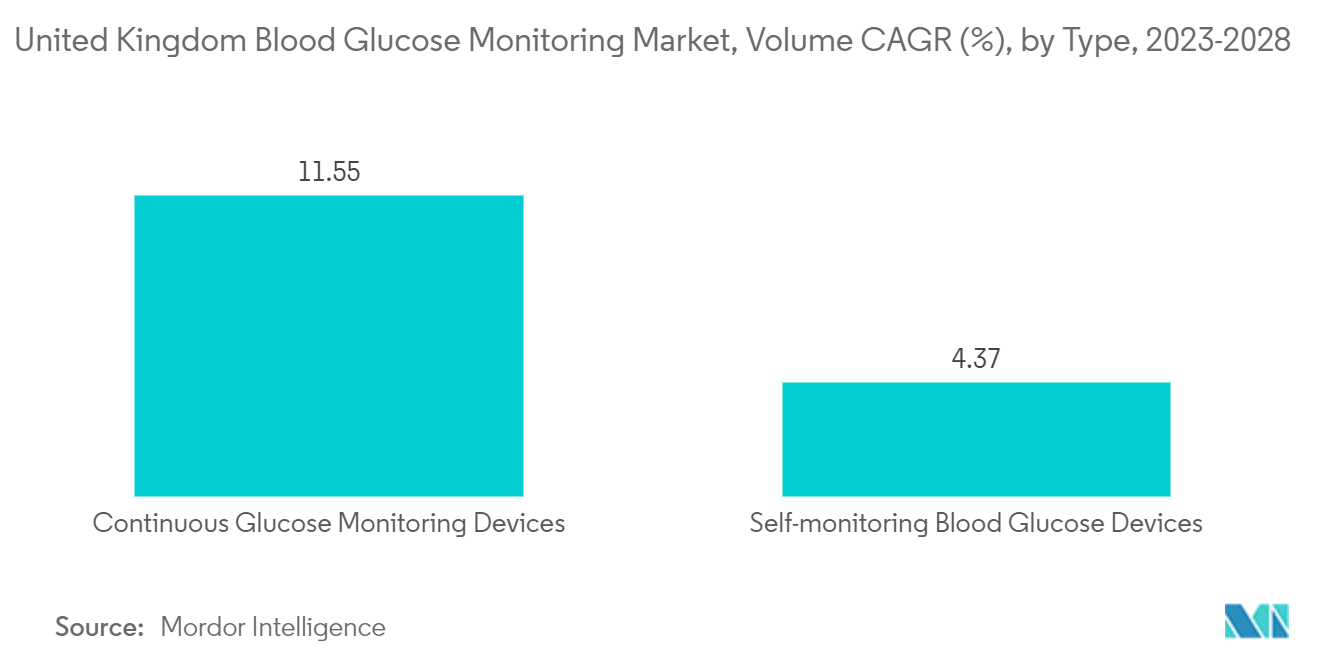
United Kingdom Blood Glucose Monitoring Industry Overview
The United Kingdom blood glucose monitoring market is moderately fragmented, with few significant and generic players. There have been constant innovations driven by manufacturers such as Abbott, Dexcom, Medtronic, etc. while also adhering to organic growth strategies, which is evident from the R&D spending of these companies.
United Kingdom Blood Glucose Monitoring Market Leaders
-
Lifescan
-
Dexcom
-
Roche Diabetes Care
-
Abbott Diabetes Care
-
Ascensia Diabetes Care
*Disclaimer: Major Players sorted in no particular order
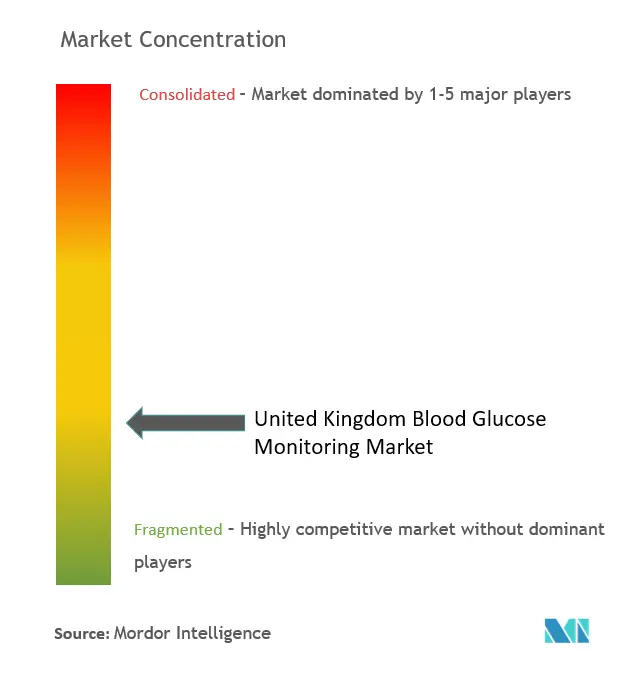
United Kingdom Blood Glucose Monitoring Market News
- September 2023: Medtronic received the CE (Conformité Européenne) Mark approval for its new all-in-one, disposable Simplera continuous glucose monitor (CGM) featuring a simple, two-step insertion process. The no-fingerstick sensor does not require overtape and is seamlessly integrated with the InPen smart insulin pen, which provides real-time, personalized dosing guidance to help simplify diabetes management.
- June 2023: Afon Technology, a Welsh-based med-tech startup, is working to develop Glucowear, a non-invasive, real-time, continuous wearable glucose monitor.
United Kingdom Blood Glucose Monitoring Market Report - Table of Contents
1. INTRODUCTION
- 1.1 Study Assumptions and Market Definition
- 1.2 Scope of the Study
2. RESEARCH METHODOLOGY
3. EXECUTIVE SUMMARY
4. MARKET DYNAMICS
- 4.1 Market Overview
- 4.2 Market Drivers
- 4.3 Market Restraints
-
4.4 Porter's Five Forces Analysis
- 4.4.1 Bargaining Power of Suppliers
- 4.4.2 Bargaining Power of Consumers
- 4.4.3 Threat of New Entrants
- 4.4.4 Threat of Substitute Products and Services
- 4.4.5 Intensity of Competitive Rivalry
5. MARKET SEGMENTATION
-
5.1 Type
- 5.1.1 Self-monitoring blood glucose devices
- 5.1.1.1 Glucometer Devices
- 5.1.1.2 Test Strips
- 5.1.1.3 Lancets
- 5.1.2 Continuous blood glucose monitoring devices
- 5.1.2.1 Sensors
- 5.1.2.2 Durables (Receivers and Transmitters)
-
5.2 Distribution Channel
- 5.2.1 Online
- 5.2.2 Offline
6. MARKET INDICATORS
- 6.1 Type-1 Diabetes population
- 6.2 Type-2 Diabetes population
7. COMPETITIVE LANDSCAPE
-
7.1 COMPANY PROFILES
- 7.1.1 Abbott Diabetes Care
- 7.1.2 Roche Diabetes Care
- 7.1.3 LifeScan
- 7.1.4 Dexcom Inc.
- 7.1.5 Medtronic PLC
- 7.1.6 Arkray Inc.
- 7.1.7 Ascensia Diabetes Care
- 7.1.8 Agamatrix Inc.
- 7.1.9 Bionime Corporation
- 7.1.10 Acon Laboratories Inc.
- 7.1.11 Trivida Health
- *List Not Exhaustive
-
7.2 COMPANY SHARE ANALYSIS
- 7.2.1 Self-monitoring Blood Glucose Devices
- 7.2.1.1 Abbott Diabetes Care
- 7.2.1.2 Roche Diabetes Care
- 7.2.1.3 LifeScan
- 7.2.1.4 Other Self-monitoring Blood Glucose Devices
- 7.2.2 Continuous Glucose Monitoring Devices
- 7.2.2.1 Dexcom Inc.
- 7.2.2.2 Medtronic PLC
- 7.2.2.3 Abbott Diabetes Care
- 7.2.2.4 Other Continuous Glucose Monitoring Devices
8. MARKET OPPORTUNITIES AND FUTURE TRENDS
** Subject To AvailablityUnited Kingdom Blood Glucose Monitoring Industry Segmentation
Blood glucose monitoring devices are used to diagnose both hyperglycemic and hypoglycemic conditions in diabetic patients. The United Kingdom's blood glucose monitoring market is segmented into types and components. The report offers the value (in USD) and volume (in units) for the above segments.
| Type | Self-monitoring blood glucose devices | Glucometer Devices |
| Test Strips | ||
| Lancets | ||
| Type | Continuous blood glucose monitoring devices | Sensors |
| Durables (Receivers and Transmitters) | ||
| Distribution Channel | Online | |
| Offline |
United Kingdom Blood Glucose Monitoring Market Research FAQs
How big is the United Kingdom Blood Glucose Monitoring Market?
The United Kingdom Blood Glucose Monitoring Market size is expected to reach USD 557.34 million in 2024 and grow at a CAGR of 8.40% to reach USD 834.18 million by 2029.
What is the current United Kingdom Blood Glucose Monitoring Market size?
In 2024, the United Kingdom Blood Glucose Monitoring Market size is expected to reach USD 557.34 million.
Who are the key players in United Kingdom Blood Glucose Monitoring Market?
Lifescan, Dexcom, Roche Diabetes Care, Abbott Diabetes Care and Ascensia Diabetes Care are the major companies operating in the United Kingdom Blood Glucose Monitoring Market.
What years does this United Kingdom Blood Glucose Monitoring Market cover, and what was the market size in 2023?
In 2023, the United Kingdom Blood Glucose Monitoring Market size was estimated at USD 510.52 million. The report covers the United Kingdom Blood Glucose Monitoring Market historical market size for years: 2021, 2022 and 2023. The report also forecasts the United Kingdom Blood Glucose Monitoring Market size for years: 2024, 2025, 2026, 2027, 2028 and 2029.
United Kingdom Blood Glucose Monitoring Industry Report
Statistics for the 2024 United Kingdom Blood Glucose Monitoring market share, size and revenue growth rate, created by Mordor Intelligence™ Industry Reports. United Kingdom Blood Glucose Monitoring analysis includes a market forecast outlook 2029 and historical overview. Get a sample of this industry analysis as a free report PDF download.



